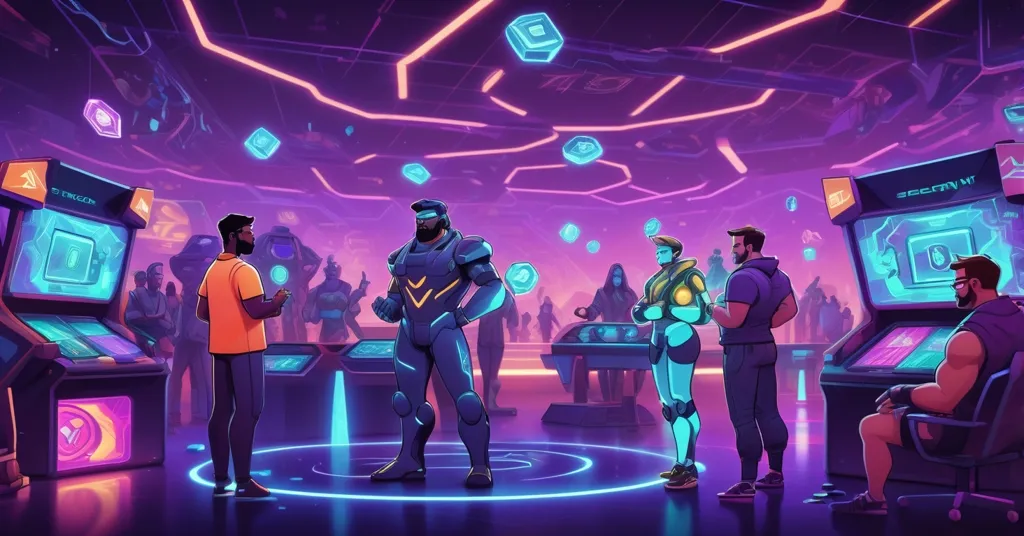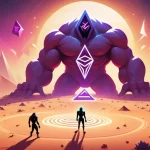Coinbase’s Jesse Pollak: Blockchain Could 10x Fortnite’s Economy, But Skeptics Disagree

Could Blockchain Revolutionize Fortnite’s Economy? Coinbase’s Jesse Pollak Says Yes, But Skeptics Aren’t Convinced
Jesse Pollak, the head of Base, Coinbase’s Ethereum layer-2 network, recently ignited a heated discussion on Crypto Twitter by declaring that Fortnite’s in-game economy could be “10x better onchain.” His vision of blockchain-powered gaming promises true asset ownership and unleashed creativity, but not everyone is ready to jump on the battle bus. Let’s break down this clash of Web3 dreams and Web2 realities to see if blockchain can truly level up a giant like Fortnite.
- Onchain Potential: Pollak claims blockchain could transform Fortnite with player-owned assets, free-market trading, and lower fees.
- Skeptical Reality Check: Critics argue Web2 platforms like Roblox already offer superior tools, with blockchain risking a worse user experience.
- GameFi’s Bumpy History: Past failures like Axie Infinity and abysmal retention rates question the viability of onchain gaming.
The Onchain Dream: Pollak’s Vision for Fortnite
Pollak’s argument is rooted in the ethos of decentralization, a concept close to the heart of Bitcoin maximalists and Web3 advocates like us. He envisions Fortnite—Epic Games’ cultural juggernaut with millions of players—running its economy on a blockchain, a public digital ledger where transactions and ownership are recorded transparently without a central authority. This means players wouldn’t just “rent” skins, emotes, or weapons for V-Bucks (Fortnite’s in-game currency) but would genuinely own them as digital assets, often in the form of non-fungible tokens (NFTs)—unique digital items akin to owning a one-of-a-kind trading card, but online. These assets could be traded on open markets, with prices set by supply and demand, not Epic’s pricing team.
For Epic Games, Pollak sees an open economy as a creative goldmine. Third-party developers could build on Fortnite’s framework, crafting new experiences, tools, or even mini-games that a single company couldn’t imagine alone. Blockchain’s global reach could also slash platform fees—those pesky cuts Epic takes on every transaction—and make purchases borderless, letting players from anywhere tap into the same marketplace. It’s a rebellious middle finger to centralized control, handing power back to players and creators alike, as Coinbase’s Jesse Pollak has argued.
“Fortnite’s in-game economy could be ‘10x better onchain.’ For the company: because then their entire economy is open for anyone else to build on… For the players: because then they actually own their assets, the free market prices them, and they can win in real life when they win in the game.” – Jesse Pollak
The Web2 Reality: Why Skeptics Like Wang Push Back
Not everyone’s sipping the onchain Kool-Aid, though. John Wang, co-founder of Armor Labs and a former product manager at Immutable, a Web3 gaming platform, brings a no-nonsense critique to the table. He argues that Web2 platforms—traditional, centralized systems like Roblox—already deliver tools that leave blockchain in the dust. Roblox, for instance, empowers developers with detailed analytics, letting them see how players interact with their games and adjust prices by region for maximum profit. These capabilities come without the clunky baggage of blockchain, like slow transactions or the hassle of setting up crypto wallets, a point of contention in many discussions about Fortnite’s potential blockchain integration.
Wang’s sharpest jab? Moving Fortnite onchain might actually be a downgrade for Epic Games. Lower fees sound great for players, but for a company raking in billions (Fortnite reportedly generates over $5 billion annually), losing control over transaction cuts could dent revenue hard. Worse, the user experience could take a nosedive—imagine a 12-year-old trying to buy a skin but fumbling through gas fees (transaction costs on blockchain networks) or waiting minutes for a purchase to confirm. Wang’s point is brutally clear: why gamble on a tech that’s costlier to implement and shittier to use when your current setup prints money?
“Why would it be better for the game company for their game to be onchain? I think going onchain is strictly worse for them because lower fees + worse experience.” – John Wang
Pollak pushes back, insisting blockchain offers “more expressive and powerful” financial tools than Web2 servers. He argues that onchain systems can handle complex transactions transparently on a public ledger, with the flexibility to add restrictions if needed. Picture a Fortnite where every skin trade or V-Buck spend is visible, and winning a match could mean cashing out real-world value. It’s a tantalizing idea for those of us who dream of breaking free from corporate walled gardens, but the tech and adoption hurdles are hard to ignore, as highlighted in broader critiques of Pollak’s views on blockchain gaming.
GameFi’s Checkered Past: Lessons from Axie Infinity and Beyond
To understand the stakes for Fortnite, we need to look at the rocky road of blockchain gaming, often called GameFi—a fusion of gaming and decentralized finance. GameFi exploded in 2021-2022 with “play-to-earn” models like Axie Infinity, where players battled cute digital creatures to earn crypto tokens, supposedly making a living. Spoiler alert: it was less “dream job” and more “digital disaster.” Axie’s token economy collapsed in a death spiral when user growth stalled, compounded by security breaches that bled millions. Many players, especially in economically struggling regions, ended up in debt after investing in the game’s NFTs, expecting profits that never came, a cautionary tale detailed in recent analyses of GameFi challenges.
The numbers are grim. Over 60-70% of GameFi users ditch these platforms within 30 days, compared to 25-40% retention in Web2 gaming. Adoption lags behind traditional platforms, costs for players and developers are sky-high (think Ethereum gas fees before layer-2 solutions), and too many projects peddle get-rich-quick schemes while gameplay rots—pure snake oil in pixel form. For a behemoth like Fortnite, with a polished, centralized ecosystem, these horror stories scream caution. Prioritizing crypto hype over fun could alienate millions of players who just want to floss and frag, not speculate on token prices.
Web3 Gaming Today: Innovations and Persistent Pitfalls
Despite the carnage, GameFi isn’t a corpse yet. The sector holds a $13.2 billion market cap as of 2024, even as daily active users have plummeted 74% from a 2022 peak of 1.6 million to around 400,000. Newer models like “Play-and-Own”—focusing on asset utility over pure earnings—and “Create-to-Earn”—rewarding user-generated content with NFTs—aim to shift the focus from speculation to engagement. Specialized blockchain networks like Ronin, ImmutableX, and zkSync L3 are tackling the cost and speed issues that plague Ethereum-based games, offering low-fee, high-throughput environments tailored for gaming microtransactions.
Companies like Immutable are also bridging the Web2-Web3 gap. Their partnerships with giants like Ubisoft (think Might & Magic Fates) show blockchain can enhance, not replace, traditional gaming, as seen in recent updates on Immutable’s collaboration with Ubisoft. Immutable Play, a tool for building pre-launch audiences, works for games whether they’re onchain or not, proving Web3 doesn’t have to be a hard sell. But the specter of speculation still looms—too many projects dangle financial carrots over genuine fun, burning through hype faster than a Fortnite match. For Epic Games, the question remains: why risk a billion-dollar empire on a tech with such a spotty track record?
Technical Hurdles: Can Blockchain Handle Fortnite’s Scale?
Let’s get into the nitty-gritty. Fortnite isn’t a niche indie game—it’s a monster with millions of daily microtransactions. Blockchain, especially Ethereum, has historically struggled with scalability. High gas fees and slow confirmations could turn a quick skin purchase into a frustrating slog. Pollak’s Base, as an Ethereum layer-2 solution, aims to fix this by batching transactions off the main chain to cut costs and boost speed. Similar networks like Ronin (built for Axie Infinity, ironically) show promise for gaming-specific use cases. But even layer-2s aren’t bulletproof—Fortnite’s sheer volume could still strain these systems, and onboarding casual gamers to crypto wallets remains a UX nightmare. Does the average Fortnite fan care about “true ownership” when they’re just here for a quick Battle Royale fix, a concern echoed in debates on how blockchain could improve Fortnite’s economy?
A Middle Path? Hybrid Models for Fortnite
Here’s where a compromise might shine. Instead of a full onchain overhaul, Fortnite could dip its toes into blockchain with optional features. Imagine a limited-edition skin drop as NFTs, tradable globally via smart contracts (self-executing code on blockchain) with Epic taking a small cut. Players who want simplicity stick to V-Bucks, while crypto-savvy fans trade assets for real-world value. SocialFi elements—think on-chain guild systems or achievements—could boost community stickiness, appealing to Gen Z gamers and streamers who crave social clout over quick bucks. Companies like Immutable already pave this hybrid path, letting developers integrate Web3 subtly without alienating traditional audiences.
But let’s play devil’s advocate. Even a hybrid model risks bots scooping up rare assets or kids falling for scams—issues GameFi hasn’t fully solved. A misstep could tarnish Fortnite’s family-friendly brand, especially if players lose money to shady marketplaces. Epic might look at this and say, “Screw it, our centralized model works fine.” And honestly, for most players who just want to game, not invest, they might be right, a sentiment shared in critiques of blockchain gaming’s hurdles and Fortnite’s potential.
What If Fortnite Goes Onchain? A Speculative Scenario
Picture this: Epic launches a blockchain pilot for Fortnite Chapter 6. They drop 10,000 exclusive skins as NFTs, each tied to real-world value, tradable on a marketplace built with Base. Players buy in with crypto or V-Bucks, and every trade is transparent on the blockchain. Streamers and esports pros hype it up, turning rare skins into status symbols worth thousands. Epic nets a 5% cut via smart contracts, while players cash out real money from in-game wins. It’s a decentralized dream—until bots snatch 80% of the drop in seconds, or a phishing scam wipes out a kid’s wallet. The potential’s there, but so are the landmines. Fortnite would need ironclad security and dead-simple UX to pull this off without a PR disaster, a balancing act explored in discussions of Jesse Pollak’s vision for an onchain Fortnite economy.
Key Takeaways and Burning Questions
- How Could Blockchain Transform Fortnite’s Economy?
Blockchain could enable true ownership of in-game items like skins as NFTs, allow free-market trading with real-world value, and spark creativity through third-party developer access, potentially with lower fees and global reach. - Why Are Experts Skeptical of Blockchain in Fortnite?
Web2 platforms like Roblox already provide robust analytics and pricing tools, while blockchain risks higher implementation costs, clunky user experiences, and adoption barriers for casual gamers. - What Can Fortnite Learn from GameFi Failures Like Axie Infinity?
Past play-to-earn flops reveal the danger of prioritizing crypto profits over fun, with unsustainable token models and security breaches burning players—gameplay must remain king. - Is There a Hybrid Web2-Web3 Path for Gaming Giants Like Epic?
Yes, selective blockchain integration—think optional NFT drops or on-chain social features—could enhance Fortnite without forcing complex tech on all players, as seen with Immutable’s partnerships. - Can Blockchain Gaming Shake Its Bad Reputation?
With a $13.2 billion market and shifts to sustainable models like Play-and-Own, there’s hope, but only if costs drop, retention climbs, and projects ditch speculative nonsense for real engagement.
Pollak’s vision for an onchain Fortnite is a bold call to disrupt centralized gaming empires, resonating with our push for decentralization and freedom. But Wang’s skepticism is a gut punch of reality—blockchain’s not a magic wand, and GameFi’s scars run deep. A hybrid approach might be the sweet spot, letting Fortnite experiment without betting the farm. For now, though, the tech, adoption, and design aren’t quite there to guarantee a 10x economy. Will Epic dare to test these waters, or is this just another crypto pipe dream? One thing’s certain: the clash between Web2 efficiency and Web3 ideals is a battle royale worth watching, and gaming could be where decentralization finally proves its mettle—or crashes harder than a noob in a 100-player lobby.



